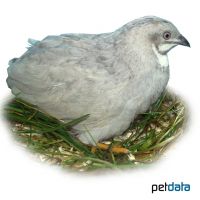Silver Blue-breasted Quail (Synoicus chinensis)
| Silver Blue-breasted Quail Synoicus chinensis | |
|---|---|
| Name | Silver Blue-breasted Quail |
| Name Lat. | Synoicus chinensis |
| Family | Partridges & Old World Quails |
| Family lat. | Phasianidae |
| Order | Gallinaceous Birds |
| Order lat. | Galliformes |
| Origin | South Asia |
| Climate | Subtropical - tropical |
| Diet | Quail seed, plant matter |
| Keeping | Pair, group |
| Care Level | Easy |
| Reproduction | Ground nest |
| Life Span | 3-6 years |
| Protection | No |
| Metric Units | |
| Size | 13 cm |
| Temperature | Room temperature |
| Housing | 120 x 60 x 100 cm |
| US Units | |
| Size | 5.1" |
| Temperature | Room temperature |
| Housing | 45" x 25" x 40" |
Distribution and habitat
The China pygmy quail, the smallest chicken bird, is a ground dweller. The range of the wild form extends from Sri Lanka and India through Indonesia to Australia and New Caledonia, where they live in swampy and dry grasslands and cultivated land. They are bred in many color mutations.
Cage size
The cage size should be at least 120 x 60 x 100 cm (L x W x H) for a pair and should not be less than this, even in justified single keeping. For an additional 2-3 birds, the floor space must be expanded accordingly, provided that the species is compatible
The cage must be placed in a bright, draught-free and quiet place, have a rectangular base and should be opaque on one side. Keeping in a combined indoor/outdoor aviary is recommended.
Maintenance
The ground must be covered with sand, wood granulate, bark mulch, turf, soil or similar material and must be cleaned regularly. The minimum equipment includes biotope-like hiding, sleeping and nesting places with densely planted areas (grasses), roots and stones. In addition, they need, according to their natural needs, a sand bath with fine sand (e.g. chinchilla sand). The room temperature must not fall below 10 °C.
Diet
The species-specific feed offer consists of mixed seeds, available in specialized trade as "exotic feed" in premium quality, supplemented with foxtail millet, green feed (chickweed, green panicle millet, fresh grass panicles, cucumber slices, organic lettuce, etc.), tangle grass seeds, insect feed and especially for the raising of young germinated seeds (millet, oats), egg feed (chopped egg and insect larvae.), tangle grass seeds, insect food and especially for raising young germinated seeds (millet, oats), egg food (chopped egg) and insect larvae, such as small, skinned mealybug larvae, ant pupae and small buffalos. Charcoal, vitamine lime, shell grit, small stones and crushed chicken shells are needed as digestive aids. Drinking water must always be available in birdbaths or in stable, open containers and, like food, must be offered fresh daily in clean containers.
A varied diet promotes health and prevents deficiency symptoms.
Reproduction and breeding
The male has a black throat bib and a white throat-cheek stripe. The female is more brownish with sparse breast stripes.
They are ground breeders that like to breed in biotope-like, protected grassy hollows. Suitable nesting materials include coconut fibers, long grasses, and small roots. The clutch consists of 4-8 eggs, the incubation period is about 16 days. The incubation period is, biologically speaking, from April to September when kept in outdoor aviaries. During the breeding season, dwarf quail should be kept only in pairs, not in a group. When breeding, the room temperature should be at least 15 °C.
Species protection
They are exempt from the obligation to notify (Federal Species Protection Ordinance Annex 5 to § 7 para. 2). Your pet store will be happy to provide you with further information.
Important
In the case of outdoor aviaries, they also need a heated shelter with a floor area of at least 1 m², which can be visited by the birds at any time. The temperature in the shelter must not fall below 10 °C and the furnishings must correspond to those of cage keeping.
They may only be kept in pairs or in a group, one male with up to four females. Males in an aggressive phase should be kept singly. They can be well socialized with finches or parakeets.
In rooms, including shelters, adequate daylight or flicker-free artificial light (stroboscopic effect) corresponding to daylight should be provided. The lighting duration shall be 8-14 hours per day and the natural day-night rhythm shall be observed. Adequate indoor climate shall be provided. The health condition of the birds shall be checked daily
Further literature can be found in your pet store.
References
Text: Othmar Sieberer; Image: petdata
Source: ROBILLER (1986): Lexikon der Vogelhaltung, Edition Leipzig; GRUMMT & STREHLOW (2009): Zootierhaltung - Tiere in menschlicher Obhut: Vögel, Verlag Harri Deutsch
- Gemäß § 21 Abs. 5 Tierschutzgesetz idgF
